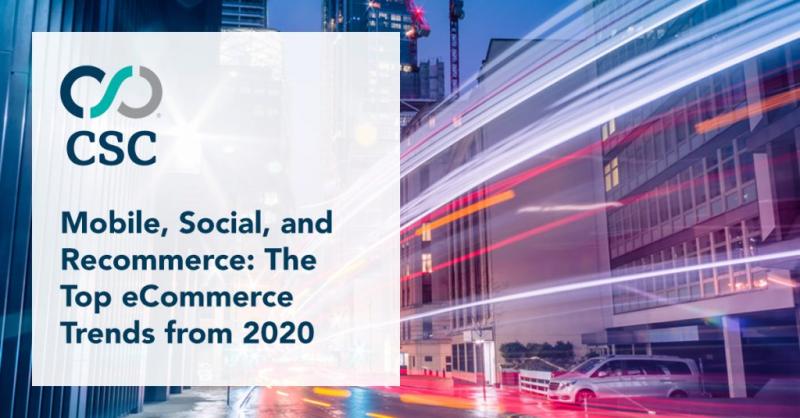
By Agnes Czolnowska,
Subject Matter Expert, CSC Marketplace ResearchShare this post 


This year has seen rapid growth for eCommerce, with people turning to online shopping more than ever due to lockdowns and quarantine restrictions. Recent studies have shown that the COVID-19 pandemic has accelerated the shift away from physical stores to digital shopping by roughly five years[1].
In this article, we look at trends from 2019 and 2020 that have shaped the eCommerce landscape.
Trend 1: Mobile shopping is still on the move
In 2019, 53% of eCommerce sales were made using a mobile device[2]; by the end of 2021, it’s predicted that number will be 73%[3]. One of the biggest advantages of mobile shopping for consumers—and arguably the main reason for its increase in popularity—is the ability to shop from anywhere at any time. Some eCommerce platforms have even been created with mobile commerce as a primary focus, in some cases developing a desktop version of their site at a later stage.
Unfortunately, new eCommerce platforms rarely prioritize intellectual property (IP) protection as part of their sites’ development. This means that opportunistic sellers can offer counterfeit goods on the marketplace early on, with few or no restrictions. Without the prompt adoption of sufficient controls to limit the appearance of counterfeits, a platform could risk its reputation as being a site that’s an outlet for low quality selloffs and counterfeit items. Hong Kong-based Vova.com, for example, began its activities in late 2018, strongly promoting its mobile app from the start and offering additional discounts to app users. The platform offers a variety of “affordable items featuring your favorite designs”—wording that is strikingly similar to that seen on listings for counterfeit goods.
The biggest challenge for enforcing against new marketplaces is by far communication. The lack of focus on IP rights protection means there is rarely a dedicated team within the marketplace with a thorough understanding of IP abuse, rendering them unable to attend to infringement complaints effectively.
Trend 2: Customers are shopping through social media channels
Social commerce—making purchases directly on social media platforms—has been steadily gaining ground over the past few years.
The fact that the first announcement regarding Facebook® Marketplace was made in 2007 shows its innovative thinking—no one else appeared to be considering linking social media with selling. Ten years later, Facebook officially launched its Facebook Marketplace to the world.
Initially it only allowed users to buy and sell from each other within their communities, but more recently, it’s expanded to include merchant selling. This provides an additional channel for small and medium-sized businesses to maximize online revenue. Elsewhere, platforms like Shopify® allow businesses to link their online stores with social media sites so people can buy directly through social media. This business presence on Facebook Marketplace will allow for a flow of new product offerings, but with this increase will also come an increase in counterfeits.
Geo-location is a big challenge when it comes to effective monitoring and enforcement of infringing content on social media marketplaces—ads and groups tend to target users in the same region, rather than being more global. Monitoring therefore needs to cover a number of locations to be more accurate. Facebook offers special ads and a commerce IP tool for enforcement of infringing marketplace content; however, the tool still requires development and is currently not useful for managing enforcement cases.
Trend 3: Recommerce
Driven in large part by Millennials and Generation Z, the resale, or “recommerce”, market is booming. As the COVID-19 pandemic continues, it’s likely that its share of the market will grow. Thrift shopping has grown tremendously over the past few years, and with lockdowns through much of 2020, consumers’ purchasing attitudes are changing, and so recommerce is likely to become more mainstream.
We have seen several, mainly fashion-oriented, recommerce platforms boom in recent years, including brands such as Vinted, Depop, and Poshmark.
These peer-to-peer recommerce platforms rely on their reputation among sellers, and therefore they all have policies in place concerning counterfeits. Some sellers use unauthorized references to known brands to draw attention to their listings, e.g., “Brand X style” or “just like Brand X.” It will take time for sellers to adhere to proper use of trademarks IP rules.
Challenges for brand owners
What IP protection and enforcement challenges does this accelerated eCommerce growth present to brand owners, and what are the best strategies to approach the ever-increasing numbers of eCommerce sites?
- Think about trademark portfolio strategy. Ensure that it considers potential online enforcement. Fraudsters and sellers will pop up worldwide, and not necessarily only in those jurisdictions where a brand owner’s trademark is registered.
- Make your trademark portfolio adaptable. This allow brand owners to adjust to sellers’ behavioral changes. Think about how you’ll deal with sellers offering counterfeit products, but who avoid actually referencing the trademarked brand name. What is your logo registration status? Are there any unique elements of a product that could be 3D trademarked?
- Make your customers your allies. Consider including an option for the public to report potential counterfeits via your brand website. It could act in your favor to show a proactive approach to investigating and addressing potential counterfeit concerns, and a willingness to take active steps to protect the end consumer.
- Build relationships with marketplaces. A brand’s cooperation and ongoing dialogue with marketplaces can help build counterfeit-preventing strategies as well as more robust enforcement processes.
We’re ready to talk If you’d like to speak to one of our experts about CSC’s Brand Monitoring solutions, please complete our contact form.
[1] finance.yahoo.com/news/ibm-2020-u-retail-index-150119824.html
[2] thedrum.com/opinion/2020/02/19/mobile-accounts-65-all-ecommerce-traffic-so-why-are-mobile-sales-still-lagging#:~:text=According%20to%20data%20from%20our,of%20sales%20happen%20via%20mobile
[3] statista.com/chart/13139/estimated-worldwide-mobile-e-commerce-sales/